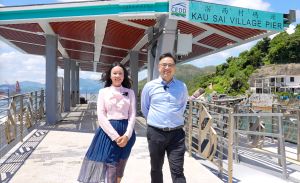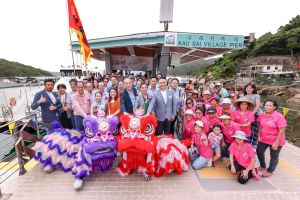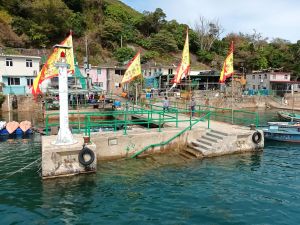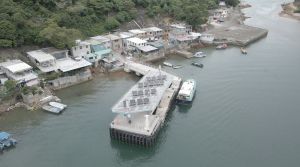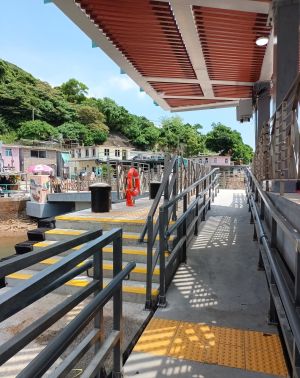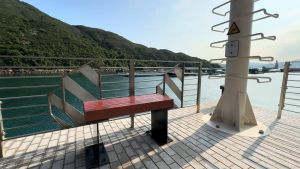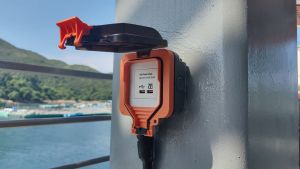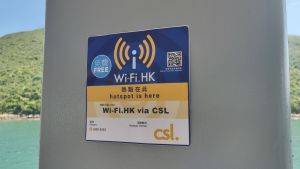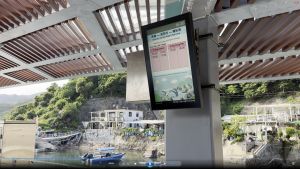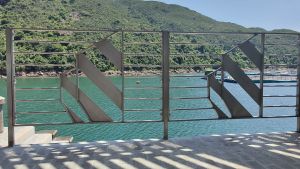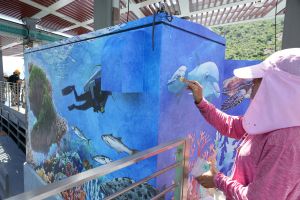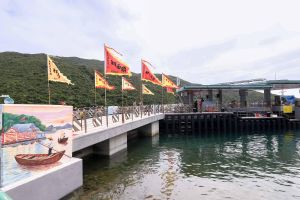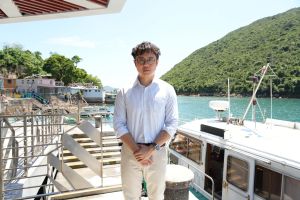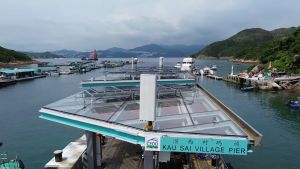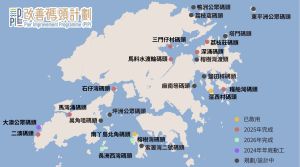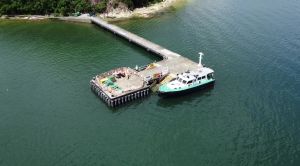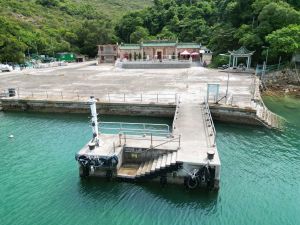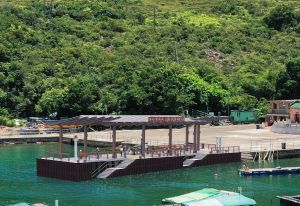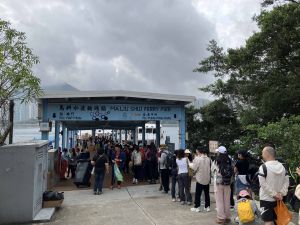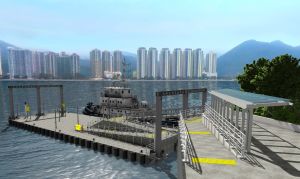Implementing Pier Improvement Programme for Public Convenience: Commissioning of New Kau Sai Village Pier in Sai Kung
|
To facilitate the travel needs of residents and tourists in remote areas, as well as the operational needs of fishermen, the Government is implementing the Pier Improvement Programme (the Programme). Under the Programme, public piers are reconstructed or constructed and pier facilities are upgraded to enhance the marine traffic to and from remote areas in the New Territories and outlying islands, and to support the development of local blue-green tourism. Following the commissioning of Pak Kok Pier on Lamma Island in end-2022, the new Kau Sai Village Pier of Sai Kung was officially opened last Saturday (21 September). This time, I have invited colleagues from the Development Bureau (DEVB) and the Civil Engineering and Development Department (CEDD) to brief us on the new Kau Sai Village Pier and the latest progress of the Programme. Increased berths and enhanced ancillary facilities at New Kau Sai Village Pier Assistant Secretary (Works Policies) of the DEVB, Miss Shirley LEUNG, states that the Kau Sai Village Pier is located at the southern tip of Kau Sai Chau in Sai Kung District. Currently, there is a kaito ferry route operating on weekends and holidays to serve Sai Kung, Kau Sai Village and Leung Shuen Wan. The inadequate water depth at the old Kau Sai Village Pier makes it difficult for vessels to berth at low tide. In addition, the pier was small with only one primitive berth, which could hardly meet the high demand during holidays or festivals, particularly during the annual Hung Shing Festival. Engineer of the CEDD, Mr Albert LEUNG, explains that the water depth for berthing of the new pier, which has been rebuilt to address the shortcomings of the old one, has improved and three berths are currently provided, one of which is equipped with a ramp for easier access for passengers in need. The new pier also offers a variety of ancillary facilities, including a roof, benches, a water dispenser, charging ports, Wi-Fi and an information display panel to enhance users’ convenience and experience. Moreover, to reflect the historical characteristics of Kau Sai Village as a fishing village, the railings feature sailboat patterns symbolising fishermen who earn their living by fishing and live on boats. We have also collaborated with the villagers to paint beautiful pictures on pillar boxes to depict their impressions of Kau Sai Village, which can add colour and local sentiment to the pier. New pier well received by both villagers and the kaito ferry operator Business Development and Compliance Manager, Mr Bery CHAN of Tsui Wah Ferry Service (Hong Kong) Limited, the operator providing kaito ferry service there, expresses great satisfaction with the new pier, saying that the new pier is better than the old one in many aspects, such as having larger berthing spaces to enable sideways berthing that was not allowed at the old pier, and also sufficient water depth allowing vessels to berth safely even during low tide. The fishermen’s representative in Kau Sai, Mr LAW Yau-mei, states that the new pier makes it more convenient for villagers to board or alight from vessels. He thanks the Government for implementing the Programme, which addresses the needs of residents in remote areas. A villager of Kau Sai Village Mr PO points out that the old pier was small with shallow water depth, making it difficult for fireboats to berth. In the event of an emergency, villagers had to be transported to a fireboat by a feeder boat, which might delay timely assistance. He also greatly appreciates the barrier-free facilities of the new pier, which facilitate wheelchair users to board and disembark safely. Environmental mitigation measures adopted during construction The design of the new pier has fully taken into account environmental protection and sustainable development elements. The pier makes good use of natural light and environmentally friendly materials, utilising reinforced glass and eco-friendly wooden bars for the roof. Solar panels are installed on the roof, and the pier’s lighting system automatically adjusts its brightness at different times of the day to save energy. The Kau Sai Village Pier is located within the Hong Kong Geopark, in close proximity to the Kau Sai fish culture zone. During the construction, environmental mitigation measures were adopted, such as installing silt curtains and regular water quality monitoring. Also, a large number of prefabricated components were used to construct the concrete and steel structures of the pier. This approach not only reduces the environmental and ecological impacts of on-site construction, but also minimises the effects of the ebb and flow of tides and other factors on works progress, thereby enhancing construction quality and safety. Compared to traditional method of pouring concrete on site, the use of prefabricated components has significantly shortened the construction time for the main structures of the pier. Eight new piers to be completed from the end of this year to 2025 The Programme currently covers 23 public piers, two of which have been put into service. Ten piers are under construction, eight of them will be completed progressively between the end of this year and 2025. These include Lai Chi Chong Pier, Sham Chung Pier and Sam Mun Tsai Village Pier of Tai Po District; Ma Liu Shui Ferry Pier; Leung Shuen Wan Pier of Sai Kung District; Yi O Pier and Ma Wan Chung Pier on Lantau; and Shek Tsai Wan Pier at Ma Wan. The Yung Shue Wan Public Pier on Lamma Island and Sai Wan Jetty on Cheung Chau are expected to be completed in 2026. Furthermore, the improvement works for Tai O Public Pier will commence at the end of this year. The remaining piers are in the planning and design stages and the projects will be taken forward in an orderly manner. Increasing berths and enhancing pier facilities to cope with passenger flow Lai Chi Chong Pier, situated within the Geopark, is popular for the beautiful geo-trails nearby. The pier has been in use for over 60 years and requires reconstruction to effectively improve its structural condition and facilities. The improvement works will be completed by the end of this year. The new pier will provide two berths, one of which adopts a floating platform that can adjust up and down with the sea level, making it easier for vessels to berth and for passengers to board or alight. The new Leung Shuen Wan Pier, another one to be completed by 2025, is also located inside the Geopark and next to a historic Tin Hau Temple. The annual Tin Hau Festival celebration and the biennial large-scale Tin Hau parade attract a large number of visitors. The existing pier is small with only one berth and insufficient water depth, making it difficult to berth during low tide, and therefore cannot cope with the high demand during festivals, holidays and weekends. To address these problems, the new pier will offer four berths with adequate water depth to accommodate the large number of visitors during festive periods. The improvement works at the new Ma Liu Shui Ferry Pier is also scheduled for completion in 2025. The existing pier provides kaito ferry services to several popular tourist destinations, such as Lai Chi Chong, Sham Chung, and Tung Ping Chau, but the existing two berths are insufficient to meet the high volume of visitors on weekends and holidays. To cope with the high demand, floating platforms will be added near the existing pier to provide two additional berths and other facilities for diverting passengers. Finally, I warmly invite everyone to follow the newly launched website and social media platforms of the Programme (https://linktr.ee/CEDDPIP) to stay tuned on the latest development of the Programme, as well as the information about attractions and activities near these piers. |
29 September, 2024
Back